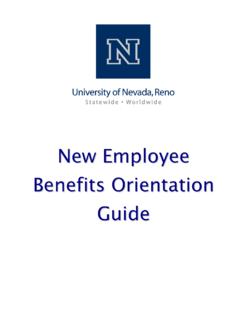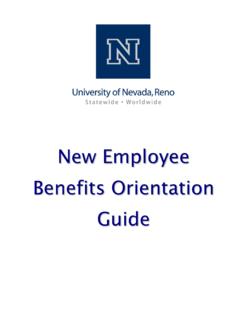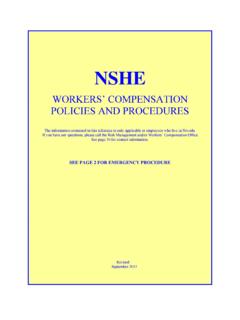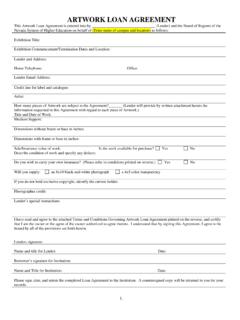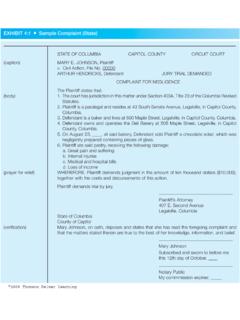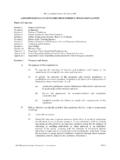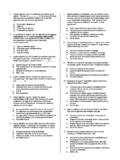Transcription of Third-Party Contract Insurance Guidelines
1 University Risk Management & Insurance Association URMIA White Paper Third-Party Contract Insurance Guidelines October 2009. John P. McLaughlin Managing Director, Higher Education Practice Arthur J. Gallagher & Co. Michael J. Gansor Risk Manager West Virginia University Editor: Christie Wahlert URMIA. This URMIA white paper is published by the University Risk Management and Insurance Association (URMIA), Box 1027, Bloomington, IN 47402-1027. URMIA is an incorporated nonprofit professional organization. Editing and layout of the October 2009 URMIA white paper was completed by Christie Wahlert, URMIA, Bloomington, Indiana, and printing was completed at Indiana University Printing Services, Bloomington, Indiana.
2 There is no charge to members for this publication. It is a privilege of member- ship. Additional copies are available by contacting the URMIA National Office at the address above or at Membership information is also available. LEGAL NOTICE AND COPYRIGHT: The material herein is copyright October 2009 URMIA; all rights reserved. Table of Contents ESTABLISHING CONTRACTUAL Insurance Guidelines 3. GENERAL Insurance REQUIREMENTS FOR ALL INSURERS 5. Insurance COVERAGES 7. Commercial General Liability 7. Automobile Liability 7. Workers' Compensation 7. Umbrella Liability 8.
3 Professional Liability 8. Pollution Liability 9. Property - Tenants/Lessees 10. Aviation 10. Builders Risk 10. Bonds 10. Self- Insurance (including Captive Insurance ) 11. Insurance REQUIREMENTS 12. Construction/Renovation Contracts 13. Vendor Agreements 17. Consulting and Professional Services Agreements 20. (Architects, Engineers, Environmental Consultants). Short-Term Lease Agreements/Special Events 25. Commercial Lease of Premises 27. Contract LANGUAGE 31. Indemnity 31. Hold Harmless and Indemnification Agreements and Non Waiver 31. Independent Contractor 32. Assignment 32.
4 Appendices APPENDIX 1 - CONSTRUCTION / RENOVATION CONTRACTS / 35. BUILDERS RISK / INSTALLATION FLOATER OPTIONS. APPENDIX 2 - VENDOR AGREEMENTS 45. APPENDIX 3 - CONSULTING AND PROFESSIONAL SERVICES 47. (ARCHITECTS, ENGINEERS, AND INFORMATION TECHNOLOGY). APPENDIX 4 - SHORT-TERM LEASE AGREEMENTS, 57. SPECIAL EVENTS, AND COMMERCIAL LEASE OF PREMISES. APPENDIX 5 - SCHEDULE OF ADDITIONAL INSURED ENDORSEMENTS 61. APPENDIX 6 - DEFINITIONS OF COMMON TERMS 63. APPENDIX 7 - EXAMPLE REQUEST LETTERS 67. To: URMIA Members From: Michael J. Gansor, Risk Manager West Virginia University Re: Third-Party Contract Insurance Guidelines The 2009 edition of the Third-Party Contract Insurance Guidelines is an informational tool to assist members in better understanding some of the Insurance coverage and policy form nuances associated with the myriad contracts risk managers are asked to review and opine on in the course of our duties.
5 We hope these Guidelines will prove to be a valuable tool in helping you manage your contractual risks. We must stress that the Third-Party Insurance Guidelines are just that Guidelines . Each state, each institution, each Insurance carrier, and each individual Contract comes with its own unique set of condi- tions and circumstances. It is incumbent on those responsible for managing contracts at your institution to ensure the terms, conditions, and Insurance coverage requested meets the needs of your speci c situa- tion. No guideline, no matter how complete, is appropriate for all situations!
6 I would like to thank our colleagues in the Gallagher Higher Education Practice for their help in prepar- ing this document. Speci cally, I would like to thank Liz McHugh, Priscilla McCoy, Laura O'Malley, and John McLaughlin. Without their assistance, this valuable resource could not have been developed. Sincerely, Michael J. Gansor The Third-Party Insurance Guidelines are just that . Guidelines . Each state, each institution, each Insurance carrier, and each individual Contract comes with its own unique set of conditions and circumstances.. Michael J. Gansor, Risk Manager, West Virginia University Third-Party Contract Insurance Guidelines 1.
7 Establishing Contractual Insurance Guidelines Every Contract has risks that must be reviewed from the perspective of protecting [College/University's]. assets. This document is designed to provide you with Guidelines and tools to help you manage those risks when you Contract on behalf of [College/University]. The inherent parts of Contract management are to: 1. Evaluate the risks involved 2. Decide whether to avoid, transfer, or accept the risks 3. Implement appropriate risk transfer and/or risk nancing mechanisms Read the Contract thoroughly, and anticipate events or situations that could happen within the scope of work Key Note About the outlined.
8 Ask yourself: 1. Who are all of the parties involved? Information and Samples 2. What kind of work is being done? Included in This Document 3. What type of accidents or losses could occur, and what is the worst case scenario in terms of These Guidelines were created nancial loss and/or injury to persons or prop- to assist staff who review, erty? 4. Are the responsibilities for the risks appropri- approve, or manage contracts. ately placed with those in the best position to They are Guidelines only. The control them? purpose of this document is to 5. What is the ability of the parties to manage the provide examples of specific risks and absorb the losses?
9 6. Is the Contract legal and enforceable? coverages, terms, and conditions you may want to consider Within the Contract , risk transfer is accomplished when asked to comment on through a combination of indemni cation, hold harm- Insurance requirements in less, and waiver of subrogation clauses. Insurance is commonly required as a means of providing the nancial your institution's contracts. support to back the Indemnitor's obligation to hold the The documents and Contract Indemnitee harmless. language specified here are intended to be template Guidelines or examples of best practices.
10 Each one should be adjusted to fit your specific institution's risk profile. A legal opinion should be sought before making any changes to existing Contract language. Third-Party Contract Insurance Guidelines 3. The goal of [College/University] is to establish Contract Guidelines for Insurance coverage that can be consistently applied with few exceptions. This can occur if [College/University] decides on the limits that it will require and sticks to that decision. This may involve withstanding pressure from contractors, architect and engineering (A/E) rms, and brokers.
